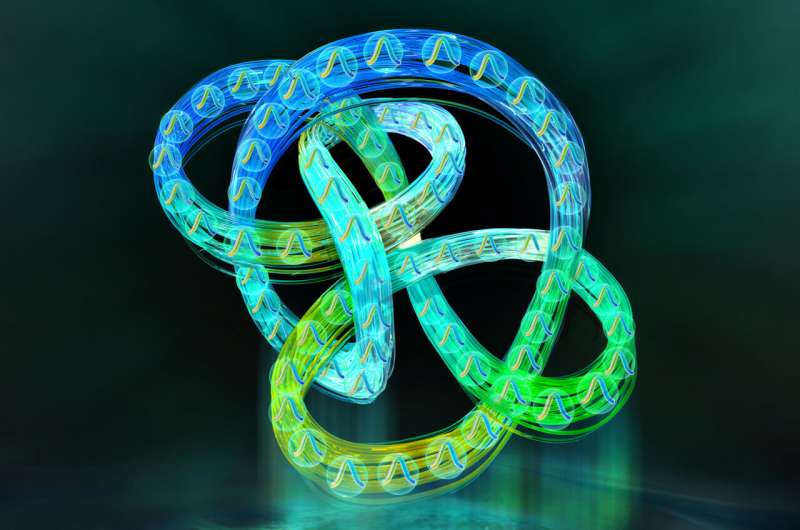March 26, 2024 feature
This article has been reviewed according to Science X's editorial process and policies. Editors have highlighted the following attributes while ensuring the content's credibility:
fact-checked
peer-reviewed publication
trusted source
proofread
Using mode-locked lasers to realize and study non-Hermitian topological physics

Mode-locked lasers are advanced lasers that produce very short pulses of light, with durations ranging from femtoseconds to picoseconds. These lasers are widely used to study ultrafast and nonlinear optical phenomena, but they have also proved useful for various technological applications.
Researchers at California Institute of Technology have recently been exploring the potential of mode-locked lasers as platforms to study topological phenomena. Their paper, published in Nature Physics, outlines the potential of these lasers for studying and realizing new non-Hermitian topological physics, with various potential applications.
"The idea of utilizing topological robustness and topological protection for photonic devices has attracted substantial attention in the past decade, yet whether such behaviors can provide substantial practical benefits remains unclear," Alireza Marandi, lead author of the paper, told Phys.org.
"We have been exploring this question specifically for lasers and nonlinear photonic devices where the functionalities are inherently nonlinear. Incidentally, the field of topological physics is also evolving around the interplay of topology and nonlinearity and the experimental platforms for such explorations are relatively sparse."
The goal of the recent study by Marandi and his colleagues was two-fold. On one hand, they wished to open new opportunities for the study of nonlinear topological behaviors, while on the other, they wished to broaden the practical application of topological physics in mode-locked lasers.
"From an experimental perspective, our platform is a time-multiplexed resonator network, which is composed of many synchronized pulses in a long resonator," Marandi explained. "The pulses can be coupled to each other in a controllable fashion using precise delay lines. This enables us to create a programmable network of large-scale resonators with substantial flexibility. This is not easy in other platforms."
In an earlier paper published in 2022, the researchers explored topological phenomena in large-scale photonic resonators, but specifically in the linear regime. As part of their new study, they used the same resonators to implement coupled mode-locked lasers.

The team showed that the pulse pattern produced by these lasers can benefit from non-Hermitian and topological phenomena. Essentially, they created a long-cavity, multi-pulse, mode-locked laser and introduced a knot inside it (i.e., coupling its pulses in a topological fashion).
"The flexibility of our experimental approach enabled us both to study the intersection of topology and laser mode-locking and to realize non-Hermitian topological physics that had not previously been demonstrated in photonic systems," Marandi said.
"For example, we found that the synergy between non-Hermitian topology and our system's nonlinear dynamics spontaneously produced skin modes in our mode-locked laser. This stands in stark contrast to linear non-Hermitian topological systems, where skin modes must be probed with an external source."
This recent work by Marandi and his collaborators demonstrates the promise of mode-locked lasers for studying topological physics that have so far been difficult to access experimentally. In addition, their study could inspire the use of mode-locked lasers for developing new sensing, computing, and communications technologies.
Moreover, in their experiments, the researchers used the laser they developed to confirm the robustness of a mathematical model used to study the behavior of randomly moving particles, known as the Hatano-Nelson model, against disorder-induced localization. While this model has been widely studied before, it had not yet been demonstrated on a mode-locked photonic platform.
"Specific to this realization, we further explored the robustness of the Hatano–Nelson model against disorder-induced localization and how it might enable the design of robust frequency comb sources," Marandi said. "Typically, this kind of robustness against something is followed by sensitivity to something else."
In their next studies, Marandi and his colleagues will try to use their approach to probe the use of Hatano-Nelson model as a sensor with enhanced sensitivity. In addition, they hope that their study will inspire other teams to experiment with the use of mode-locked lasers to study topological physical phenomena.
"We also believe that our platform can be a fertile ground for exploring a large body of nonlinear topological and non-Hermitian phenomena that are not easily accessible," Marandi added. "One such example that we are interested in is the interplay of soliton formation and topological behaviors."
More information: Christian R. Leefmans et al, Topological temporally mode-locked laser, Nature Physics (2024). DOI: 10.1038/s41567-024-02420-4
Journal information: Nature Physics
© 2024 Science X Network




















